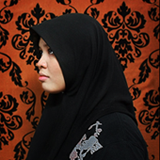

Diffused Illumination (DI) relies on the same basic principles of the contrast between the silent image and the finger that touches the surface. Infrared light (IR) is shined at the screen surface from below. A diffuser is placed on top or on bottom of the touch surface. When an object touches the surface it reflects more light than the diffuser or objects in the background; the extra IR light is sensed by a camera. Depending on the diffuser, this method can also detect hover and objects placed on the surface. DI requires infrared illuminators to function. DI also needs some sort of a diffuser material to diffuse the light that frequently doubles as the projection surface.
When the user comes into contact with the touch surface, the IR light is scattered resulting in a blob or IR light. This light blob is seen by a IR camera and relaying them to tracking software. This principle is very useful for implementing multi-touch displays, since the light that is scattered by the user is now able to exit the acrylic in a well defined area under the contact point and becomes clearly visible to the camera below. An in-system projector is used to display visual feedback on the table surface. It is important to consider that projector lamps have a mean-life expectancy of typically 6000+ hours.
http://www.touchscreenmagazine.nl/multitouch-techniques/direct-illuminationWhen the user comes into contact with the touch surface, the IR light is scattered resulting in a blob or IR light. This light blob is seen by a IR camera and relaying them to tracking software. This principle is very useful for implementing multi-touch displays, since the light that is scattered by the user is now able to exit the acrylic in a well defined area under the contact point and becomes clearly visible to the camera below. An in-system projector is used to display visual feedback on the table surface. It is important to consider that projector lamps have a mean-life expectancy of typically 6000+ hours.
Advantages
- Can use any transparent top material like hardened glass (not just acrylic)
- Can track fingers and hovering fingers
- Can recognize objects or markers
Disadvantages
- Sensitive to ambient light
- Requires a diffuser coating
- Required on site calibration
- Greater chance of ‘false blobs’ then FTIR technique

Below is a list of software needed in order for the Multi-touch pad to work.
- Touchlib
- Flash player
- Java
- Microsoft Visual C++
- tbeta (does not work on Win7)



No comments:
Post a Comment